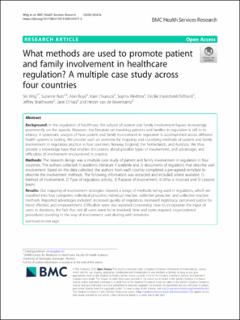| dc.contributor.author | Wiig, Siri | |
| dc.contributor.author | Rutz, Suzanne | |
| dc.contributor.author | Boyd, Alan J. | |
| dc.contributor.author | Churruca, Kate | |
| dc.contributor.author | Kleefstra, Sophia | |
| dc.contributor.author | Haraldseid-Driftland, Cecilie | |
| dc.contributor.author | Braithwaite, Jeffrey | |
| dc.contributor.author | O'Hara, Jane | |
| dc.contributor.author | van de Bovenkamp, Hester | |
| dc.date.accessioned | 2020-08-03T12:36:06Z | |
| dc.date.available | 2020-08-03T12:36:06Z | |
| dc.date.created | 2020-07-06T10:06:30Z | |
| dc.date.issued | 2020-07 | |
| dc.identifier.issn | 1472-6963 | |
| dc.identifier.uri | https://hdl.handle.net/11250/2670674 | |
| dc.description.abstract | Abstract Background: In the regulation of healthcare, the subject of patient and family involvement figures increasingly prominently on the agenda. However, the literature on involving patients and families in regulation is still in its infancy. A systematic analysis of how patient and family involvement in regulation is accomplished across different health systems is lacking. We provide such an overview by mapping and classifying methods of patient and family involvement in regulatory practice in four countries; Norway, England, the Netherlands, and Australia. We thus provide a knowledge base that enables discussions about possible types of involvement, and advantages and difficulties of involvement encountered in practice. Methods: The research design was a multiple case study of patient and family involvement in regulation in four countries. The authors collected 1) academic literature if available and 2) documents of regulators that describe user involvement. Based on the data collected, the authors from each country completed a pre-agreed template to describe the involvement methods. The following information was extracted and included where available: 1) Method of involvement, 2) Type of regulatory activity, 3) Purpose of involvement, 4) Who is involved and 5) Lessons learnt. Results: Our mapping of involvement strategies showed a range of methods being used in regulation, which we classified into four categories: individual proactive, individual reactive, collective proactive, and collective reactive methods. Reported advantages included: increased quality of regulation, increased legitimacy, perceived justice for those affected, and empowerment. Difficulties were also reported concerning: how to incorporate the input of users in decisions, the fact that not all users want to be involved, time and costs required, organizational procedures standing in the way of involvement, and dealing with emotions. Conclusions: Our mapping of user involvement strategies establishes a broad variety of ways to involve patients and families. The four categories can serve as inspiration to regulators in healthcare. The paper shows that stimulating involvement in regulation is a challenging and complex task. The fact that regulators are experimenting with different methods can be viewed positively in this regard. | en_US |
| dc.language.iso | eng | en_US |
| dc.publisher | BioMed Central | en_US |
| dc.rights | Navngivelse 4.0 Internasjonal | * |
| dc.rights.uri | http://creativecommons.org/licenses/by/4.0/deed.no | * |
| dc.subject | sykehus | en_US |
| dc.subject | pasientmedvirkning | en_US |
| dc.subject | pårørende | en_US |
| dc.title | What methods are used to promote patient and family involvement in healthcare regulation? A multiple case study across four countries | en_US |
| dc.type | Peer reviewed | en_US |
| dc.type | Journal article | en_US |
| dc.description.version | publishedVersion | en_US |
| dc.rights.holder | © The Author(s) 2020 | en_US |
| dc.subject.nsi | VDP::Medisinske Fag: 700::Helsefag: 800 | en_US |
| dc.source.journal | BMC Health Services Research | en_US |
| dc.identifier.doi | 10.1186/s12913-020-05471-4 | |
| dc.identifier.cristin | 1818669 | |
| dc.relation.project | Universitetet i Stavanger: 5091 | en_US |
| dc.relation.project | Norges forskningsråd: 275367 | en_US |
| dc.relation.project | Norges forskningsråd: 256681 | en_US |
| cristin.ispublished | true | |
| cristin.fulltext | original | |
| cristin.qualitycode | 2 | |

